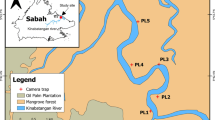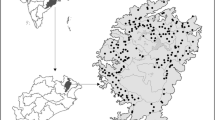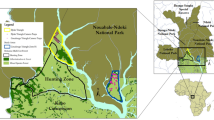Abstract
The Innoprise-IKEA (INIKEA) Forest Rehabilitation Project in Kalabakan Forest Reserve, Sabah, was established to rehabilitate degraded forest affected by conventional logging and forest fires that occurred during an El-Nino event (1982–1983). The present study aimed to investigate the responses of ground-dwelling mammals and birds to the different rehabilitation practices in INIKEA: gap-cluster planting, line planting and liberation, where enrichment planting applied in both gap-cluster and line planting. A total of 74 camera traps were deployed at random locations across reforested INIKEA plots, including plots in control areas comprising naturally regenerated forest. A total of 6534 independent photographs of medium-to-large vertebrates from 7266 camera-trap nights representing 33 species from 14 families and 7 orders were obtained. Among the detected vertebrate species, 2 are listed as Critically endangered, 5 as Endangered, 8 as Vulnerable and 6 as Near threatened on the International Union for Conservation of Nature (IUCN) Red List of Threatened Species. Mousedeer was the most frequently photocaptured species, followed by muntjac, bearded pig, sambar deer, pig-tailed macaque and crested fireback. The present study demonstrates that the rehabilitation methods applied in INIKEA have aided forest recovery, providing habitat for the ground-dwelling mammals and birds in Sabah. General forest structure, species richness and species composition did not significantly differ between the areas subjected to rehabilitation treatment and the control area. The results suggest that the liberation method should be abandoned to ensure a variety of food resources for animal species. Provided major forest components remain after disturbance, disturbed forest areas should be left to undergo natural recovery.




Similar content being viewed by others
References
Aerts R, Hundera K, Berecha G, Gijbels P, Baeten M, Van Mechelen M, Hermy M, Muys B, Honnay O (2011) Semi-forest coffee cultivation and the conservation of Ethiopian Afromontane rainforest fragments. For Ecol Manag 261:1034–1041
Alloysius D, Falc J, Yap SW, Karlsson A (2010) An attempt to rehabilitate a degraded tropical rainforest in Borneo: the biological results and the social benefits of IKEA investment, an analysis after 10 years. Paper for Poster at XXIII IUFRO World Congress, Seoul, Korea, 22–28 Aug 2010.
Ansell FA, Edwards DP, Hamer KC (2011) Rehabilitation of logged rain forests: avifaunal composition, habitat structure and implications for biodiversity-friendly REDD+. Biotropica 43:504–511
Azlan MJ, Engkamat L (2006) Camera trapping and conservation in Lambir Hills National Park, Sarawak. Raffles B Zool 54:469–475
Azlan M, Sollmann R, Bernard H, Ambu LN, Lagan P, Mannan S, Hofer H, Wilting A (2013) Density and habitat use of the leopard cat (Prionailurus bengalensis) in three commercial forest reserves in Sabah. Malaysian Borneo J Mamm 94(336):82–89
Bernard H, Ahmad AH, Brodie J, Giordano AJ, Lakim M, Amat R, Koh PH, Lee SK, Tuuga A, Malim PT, Hasegawa DL, Yap SW, Waidi S (2013) Camera-trapping survey of mammals in and around Imbak Canyon Conservation Area in Sabah, Malaysian Borneo. Raffles B Zool 61:861–870
Bernard H, Baking LE, Giordano AJ, Wearn OR, Ahmad AH (2014) Terrestrial mammals species richness and composition in tree small forest patches within an oil palm landscape in Sabah, Malaysian Borneo. Mamm Study 39:141–154
Berry N, Phillips O, Lewis S, Hill J, Edwards D, Tawatao N, Ahmad N, Magintan D, Khen C, Maryati M, Ong R, Hamer K (2010) The high value of logged tropical forests: lessons from northern Borneo. Biodivers Conserv 19:985–997
Bosso L, Ancillotto L, Smeraldo S, D’Arco S, Migliozzi A, Conti P, Russo D (2018) Loss of potential bat habitat following a severe wildfire: a model-based rapid assessment. Int J Wildland Fire 27:756–769
Brodie JF, Giordano AJ, Ambu L (2015) Differential responses of large mammals to logging and edge effects. Mamm Biol 80:7–13
Brown S, Lugo AE (1990) Tropical secondary forest. J Trop Ecol 6:1–32
Carbone C, Christie S, Conforti K, Coulson T, Franklin N, Ginsberg JR, Griffiths M, Holden J, Kawanishi K, Kinnaird M, Laidlaw R, Lynam A, Macdonald DW, Martyr D, McDougal C, Nath L, O’Brien T, Seidensticker J, Smit WN (2001) The use of photographic rates to estimate densities of tigers and other cryptic mammals. Anim Conserv 4:75–79
Cerullo GR, Edwards FA, Mills SC, Edwards DP (2019) Tropical forest subjected to intensive post-logging silviculture maintains functionally diverse dung beetle communities. For Ecol Manag 444:318–326
Chazdon RL, Peres CA, Dent D, Sheil D, Lugo AE, Lamb D, Stork NE, Miller SE (2009) The potential for species conservation in tropical secondary forests. Conserv Biol 23:1406–1417
Colwell RK (2013) Estimates: statistical estimation of species richness and shared species from samples. Version 9. User’s guide and application. http://purl.oclc.org/estimates. Assessed Nov 2017
Colwell RK, Coddington JA (1994) Estimating terrestrial biodiversity through extrapolation. Phil Trans R Soc B 345:10–118
Cordeiro NJ, Borghesio L, Joho MP, Monoski TJ, Mkongewa VJ, Dampf CJ (2015) Forest fragmentation in an African biodiversity hotspot impacts mixed-species bird flocks. Biol Conserv 188:61–71
Corlett RT (2007) What’s so special about Asian tropical forests? Curr Sci 93:1551–1557
Davidson GWH (1981) Diet and dispersion of the Great Argus Argusianus argus. Ibis 123:485–494
DeWalt SJ, Maliakal SK, Denslow JS (2003) Changes in vegetation structure and composition along a tropical forest chronosequence: implications for wildlife. For Ecol Manag 182:139–151
Diniz-Filho JAF, Bini LM, Hawkins BA (2003) Spatial autocorrelation and red herrings in geographical ecology. Global Ecol Biogeogr 12:53–64
Edwards DP, Ansell FA, Ahmad AH, Nilus R, Hamer KC (2009) The value of rehabilitating logged rainforest for birds. Conserv Biol 23:1628–1633
Edwards DP, Backhouse AR, Wheeler C, Chey VK, Hamer KC (2012) Impacts of logging and rehabilitation on invertebrate communities in tropical rainforest of northern Borneo. J Insect Conserv 16:591–599
Feng G, Zang J, Girardello M, Pellissier V, Svenning JC (2020) Forest canopy height co-determines taxonomic and functional richness, but not functional dispersion of mammals and birds globally. Global Ecol Biogeogr 29:1350–1359
Fritz SA, Bininda-Emonds ORP, Purvis A (2009) Geographical variation in predictors of mammalian extinction risk: big is bad, but only in the tropics. Ecology 12:538–549
Giman B, Stuebing R, Megum N, Mcshea WJ, Stewart CM (2007) A camera trapping inventory for mammals in a mixed use planted forest in Sarawak. Raffles B Zool 55:209–215
Granados A, Crowther K, Brodie JF, Bernard H (2016) Persistence of mammals in a selectively logged forest in Malaysian Borneo. Mamm Biol 81:268–273
Gray MA, Baldauf SL, Mayhew PJ, Hill JK (2007) The response of avian feeding guilds to tropical forest disturbance. Conserv Biol 21:133–141
Hagger V, Wilson K, England JR, Dwyer JM (2019) Water availability drives aboveground biomass and bird richness in forest restoration plantings to achieve carbon and biodiversity cobenefits. Ecol Evol 9:14379–14393
Heydon MJ (1994) The ecology and management of rain forest ungulates in Sabah, Malaysia: implications of forest disturbance. Final report to ODA/NERC project F3CR26/G1/05. Institute of Tropical Biology, University of Aberdeen, Aberdeen, UK.
IUCN (2018) The IUCN Red List of Threatened Species. Version 2018.1. http://www.iucnredlist.org. (Accessed 11 Nov 2018).
Johnsgard PA (1999) The pheasants of the world: biology and natural history, 2nd edn. Smithsonian Institution Press, Washington, DC
Kinnaird MF, Sanderson EW, O’Brien TG, Wibisono HT, Woolmer G (2003) Deforestation trends in a tropical landscape and implications for endangered large mammals. Conserv Biol 17:245–257
Lagan P, Mannan S, Matsubayashi H (2007) Sustainable use of tropical forest by reduced-impact-logging in Deramakot Forest Reserve, Sabah, Malaysia. Ecol Res 22:414–421
Legendre P, Legendre L (2012) Numerical ecology, 3rd edn. Elsevier, Amsterdam
Lindenmayer DB, Fischer J (2006) Habitat fragmentation and landscape change: an ecological and conservation synthesis. Island Press, Washington
Meijaard E, Sheil D, Nasri R, Augeri D, Rosenbaum B, Iskandar D, Setyawati T, Lammertink M, Rachmatika I, Wong A, Soehartono T, Stanley S, O’Brien T (2005) Life after logging: reconciling wildlife conservation and production forestry in Indonesian Borneo, Centre for International Forestry Research, Indonesia
Mills LS, Soule ME, Doak DF (1993) The keystone-species concept in ecology and conservation. Bio Sci 43:219–224
Myers N, Mittermeler RA, Mittermeler CG, Da Fonseca GAB, Kent J (2000) Biodiversity hotspots for conservation priorities. Nature 403:853–858
Nijman V (1998) Habitat preference of great argus pheasant (Argusianus argus) in Kayan-Mentarang National Park, East Kalimantan, Indonesia. J Ornithol 139:313–323
O’Brien TG, Kinnaird MF, Wibisiono HT (2003) Crouching tiger, hidden prey: Sumatran tiger and prey population in a tropical forest landscape. Anim Conserv 6:131–139
Payne J, Francis C, Phillips C (1985) A field guide to the mammals of Borneo. Sabah Society and WWF Malaysia, Kota Kinabalu
Payne J, Francis CM, Phillips K (2005) A field guide to the mammals of Borneo. The Sabah Society, Kota Kinabalu
Phillipps Q, Phillipps K (2016) Phillipps’ field guide to the mammals of Borneo and their ecology: Sabah, Sarawak, Brunei and Kalimatan. Natural History Publication (Borneo), Kota Kinabalu
Rautner M, Hardiono M, Alfred RJ, Radday M, Müller M (2005) Borneo: treasure island at risk. Status of forest, wildlife and related threats on the Island of Borneo. In: WWF for a living planet.
Reynolds G, Payne J, Sinun W, Mosigil G, Walsh RPD (2011) Changes in forest land use and management in Sabah, Malaysian Borneo, 1990–2010, with a focus on the Danum Valley region. Phil Trans R Soc B 366:3168–3176
Samejima H, Ong R, Lagan P, Kitayama K (2012) Camera-trapping rates of mammals and birds in a Bornean tropical rainforest under sustainable forest management. For Ecol Manage 270:248–256
Samejima H, Lagan P, Kitayama K (2013) Impacts of two different forest management practices on the abundance of mammals. In: Kitayama K (ed) Co-benefits of sustainable forestry ecological research monographs. Springer, Tokyo, pp 89–111
Smeraldo S, Bosso L, Fraissinet M, Bordignon L, Brunelli M, Ancillotto L, Russo D (2020) Modelling risks posed by wind turbines and power lines to soaring birds: the black stork (Ciconia nigra) in Italy as a case study. Biodivers Conserv 29:1959–1976
Sodhi NS, Koh LP, Clements R, Wanger TC, Hill JK, Hamer KC, Clough Y, Tscharntke T, Rose M, Posa C, Lee TM (2010) Conserving southeast Asian forest biodiversity in human-modified landscapes. Biol Conserv 143:2375–2384
Struebig MJ, Turner A, Giles E, Lasmana F, Tollington S, Bernard H, Bell D (2013) Quantifying the biodiversity value of repeatedly logged rainforests: gradient and comparative approaches from Borneo. Adv Ecol Res 48:183–224
Wearn OR, Rowcliffe JM, Carbone C, Pfeier M, Bernard H, Ewers E (2017) Mammalian species abundance across a gradient of tropical land-use intensity: a hierarchical multi-species modelling approach. Biol Conserv 212:162–171
Whitmore TC (1998) An introduction to tropical rainforests, 2nd edn. Oxford University Press, New York, USA
Wilting A, Fischer F, Bakar SA, Linsenmair KE (2006) Clouded leopards, the secretive top-carnivore of South-East Asian rainforests: their distribution, status and conservation needs in Sabah, Malaysia. BMC Ecol 6:1–27
Acknowledgements
We thank Yayasan Sabah, Sabah Forestry Department, Sabah Biodiversity Council (SaBC) and INIKEA management committee for data collection permission (Project No. 221). We are especially grateful to the Envision Conservation Group, Rika Akamatsu for lending us some of the camera traps until the end of this project. Not forgetting for the assistance at INIKEA from David Alloysius, Vita, Fred, Farina and to all our field assistant, Albert Lojingi, Ardin Lagundi, Boniventure and Dizolkeply Sundolon. We also thank Nakajima, Sugiura, Nagata and Kawamura for the statistical analysis advices. Highest gratitude to Looi Kuok Chuong, Mohd. Shahrul, Siti Joani, Ignatius and Cleesi who used to involve in the field work as well as to the field staff in Institute for Tropical Biology (ITBC) Joumin Sindum, Hong Men Chin and Maxwell. This project was funded by Kamprad Family Foundation through the Sow-a-Seed (INIKEA) project (GLA001) and UMSGreat (GUG0186-2/2017).
Author information
Authors and Affiliations
Corresponding author
Rights and permissions
About this article
Cite this article
Laneng, L.A., Nakamura, F., Tachiki, Y. et al. Camera-trapping assessment of terrestrial mammals and birds in rehabilitated forest in INIKEA Project Area, Sabah, Malaysian Borneo. Landscape Ecol Eng 17, 135–146 (2021). https://doi.org/10.1007/s11355-020-00442-7
Received:
Revised:
Accepted:
Published:
Issue Date:
DOI: https://doi.org/10.1007/s11355-020-00442-7




